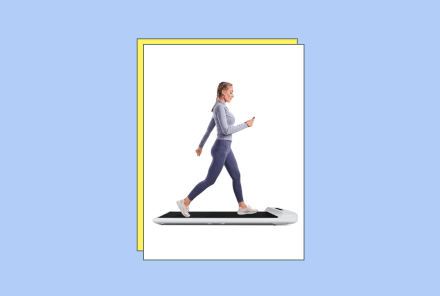Advertisement
Should You *Really* Get 10,000 Steps A Day? How To Up Your Daily Step Count

We know that moving more is generally good for your health, but squeezing in extra steps doesn’t always seem practical—or even feasible. Maybe you’re desk-bound most of the day, or your town doesn’t have a ton of sidewalks. Perhaps you just don’t have the energy for additional walking.
Here, two walking experts explain how to sneakily incorporate more steps into your routine and the benefits you’ll get from doing so. They also share tips for setting a realistic step goal (Spoiler: it’s not necessarily 10,000). Lace up and read on.
Do you really need 10,000 steps a day?
You’ve probably heard the standard recommendation of getting 10,000 steps a day, which is about five miles. This guidance has been around for decades, but where and how did it originate?
Turns out, this common guideline was likely born in 1965 when a Japanese company created a device named Manpo-kei, which translates to“10,000 steps meter.”
“The name was a marketing tool,” I-Min Lee, M.D., associate epidemiologist at Brigham and Women’s Hospital, professor of medicine at Harvard Medical School, and a researcher on physical activity said. Today, 10,000 is commonly used as the default goal on wearables and smartphones.
Marketing tactics aside, 10,000 steps is still a good goal to work towards, says Michele Stanten, certified group fitness instructor and author of The Walking Solution. It’s not a one-size-fits all, however, and “you get benefits every time you move more,” Katy Bowman, M.S., biomechanist, and author of Movement Matters and Move Your DNA explains.
A plan to reach your step goal.
To set an appropriate step goal for you, Stanten suggests first figuring out your current movement level. You can do so by using a tracker (think: old-school pedometer, smartphone app, or other smart device) to count your steps for two weekdays and one weekend without changing your routine.
Then, once you know your baseline, incrementally build from there. Say, for example, your starting daily average is 2,000 steps. Aim for 4,000 steps each day the next week, 7,000 the week after that, and 10,000 steps (or more; or less!) from there.
9 tips for sneaking in more steps.
You don’t need to schedule long walks in order to move more. There are lots of little things you can do throughout the day that will add up to big step counts.
Lean on your step tracker.
Regularly using a step tracker can help you stay accountable, says Stanten. Realizing that you’ve only covered 1,000 steps and it’s already 5 p.m., for example, might be the extra motivation you need to go on a walk around the block before dinner.
That said, you don’t need to track your steps. “I don’t really think in terms of a ‘daily step count,’” says Bowman. “More of a whole body, moving as much as I can.”
Walk between errands.
Say it’s a Saturday morning and you have a number of errands you need to knock out. Instead of driving in between each task, park in a central location and walk to and from every errand, suggests Stanten. Or, if you can accomplish all of your errands on foot from your house, that’s even better.
Walking for errands may seem to take more time, but it adds movement to your day as well as other worthy health benefits (like being in nature, for example).
Incorporate walking into your commute.
If you can, walk to work, or walk your kids to school. And if you’re limited by terrain or ability? “Drive in part way, and do the rest on foot,” Bowman says. And if you typically take public transit, walk to a farther bus stop or get off a few stops early, she adds.
Make the most of arriving early.
If you show up to an appointment, meeting, or event early, don’t just sit and scroll through your phone to pass the time. Instead, you can use the extra minutes to fit in a quick walk, says Stanten.
Enlist a walking buddy.
Having a pal to stroll with “keeps you accountable, keeps you company, and keeps you moving,” says Bowman. Another plus of walking with others: More social connection, which we know has some pretty profound mental and physical benefits.
Make multiple trips.
At home, instead of piling as many items in your arms as you can (after you’ve grocery shopped, for example), make individual trips with a couple items, suggests Stanten. Those extra trips to the car might seem negligible, but those steps count!
Take a lap around the store.
If you’re hitting up the grocery store or visiting the mall, take a lap around the building before you start shopping, says Stanten. You can also make a point to walk up and down every single aisle at the grocery store, she adds.
Deskbound? Squeeze steps into the work day.
If you need to use the bathroom or water fountain at work, pick one that’s either on a different floor or otherwise further away from your desk. You can also set hourly reminders on your phone and move around every time it goes off.
Even if you can’t leave your desk, you can still stand up, march in place, and stretch your arms overhead, says Stanten. Another idea: Whenever you take a phone call, stand up and step in place, she says.
Plan a progressive meal.
Instead of having a night out at one restaurant, plan a progressive meal. Have appetizers at one place; walk to another place for the main course; and stroll to a third locale for dessert, suggests Stanten. Bonus: Trying different restaurants can double as a fun weekend activity for your family!
Why should you up your step count?
Moving more provides lots of crazy-good benefits. Walking for regular activity can help reduce incidence of heart disease, according to an analysis of 4,207 older Americans, and it’s also associated with better self-rated health and BMI, per a study of 21,486 Spanish adults. On top of that, walking can positively impact quality of life, anxiety, and depression, concluded a study of 63 overweight/obese patients. And research involving 115 women in South Africa suggests that walking can improve blood pressure, waist circumference, and again, BMI1.
Walking more is also associated with a decreased mortality rate. A 2019 study by Lee of 16,741 older women found that those who took 4,400 steps a day over the course of a week had a 41% lower risk of dying than those who took 2,700 steps a day2 during the same period. The death rate progressively declined until about 7,500 steps a day, when the benefit leveled off. The findings suggest that even moderate increases in movement are associated with significant benefits. In other words, don’t feel discouraged if you’re not yet hitting 10,000 steps, because every step counts.
Another plus: Walking can serve as active recovery from higher-intensity activities like running and CrossFit, says Stanten. It’s a great way to still get some cardio into your day, while being gentle on your joints.
Bottom line.
There are lots of reasons to up your step count and lots of easy ways to make it happen. Though 10,000 steps a day can be a good benchmark for most folks, you can still see benefits from less. Whatever your goal, remember: every step matters. Happy trails!
2 Sources
- https://www.ncbi.nlm.nih.gov/pmc/articles/PMC6354885/
- https://jamanetwork.com/journals/jamainternalmedicine/article-abstract/2734709?guestAccessKey=afffe229-3940-4dd1-94e6-56cdd109c457&utm_source=jps&utm_medium=email&utm_campaign=author_alert-jamanetwork&utm_content=author-author_engagement&utm_term=1m
Watch Next
Enjoy some of our favorite clips from classes
Enjoy some of our favorite clips from classes
What Is Meditation?
Mindfulness/Spirituality | Light Watkins
Box Breathing
Mindfulness/Spirituality | Gwen Dittmar
What Breathwork Can Address
Mindfulness/Spirituality | Gwen Dittmar
The 8 Limbs of Yoga - What is Asana?
Yoga | Caley Alyssa
Two Standing Postures to Open Up Tight Hips
Yoga | Caley Alyssa
How Plants Can Optimize Athletic Performance
Nutrition | Rich Roll
What to Eat Before a Workout
Nutrition | Rich Roll
How Ayurveda Helps Us Navigate Modern Life
Nutrition | Sahara Rose
Messages About Love & Relationships
Love & Relationships | Esther Perel
Love Languages
Love & Relationships | Esther Perel











